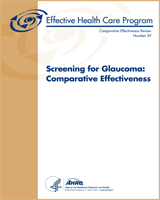NCBI Bookshelf. A service of the National Library of Medicine, National Institutes of Health.
This publication is provided for historical reference only and the information may be out of date.
Structured Abstract
Objectives:
Open-angle glaucoma (OAG) is the most common form of progressive optic neuropathy, and it is estimated that more than half of those who have glaucoma are undiagnosed. The objective of this review was to assess the effect of screening for OAG. We also summarized the accuracy of diagnostic tests.
Data Sources:
We searched MEDLINE®, Embase, LILACS, and CENTRAL through October 6, 2011. We searched MEDLINE and CENTRAL (March 2, 2011) and screened an existing database to identify relevant systematic reviews.
Review Methods:
We included studies of adult asymptomatic participants in general or high-risk populations. We included randomized controlled trials, quasi-randomized controlled trials, cohort studies, and case control studies. For diagnostic test accuracy, we included case control studies, designs in which tests were performed on all participants, and designs in which participants were randomized to one test. We included the outcomes of visual impairment, intraocular pressure, optic nerve damage, visual field progression, and harms as well as sensitivity and specificity of tests. For studies and systematic reviews, two reviewers independently assessed search results according to the inclusion criteria. One reviewer abstracted information and completed risk-of-bias assessment, and this was verified by a second reviewer.
Results:
We excluded 167 of the 169 citations found in the search for systematic reviews. One systematic review evaluated the diagnostic accuracy of screening tests for OAG. A second review evaluated the effect of screening programs on the prevention of optic nerve damage. We identified 4,960 studies, of which 83 studies addressing the accuracy of screening tests were eligible. The sensitivity of standard automated perimetry (SAP) was higher than Goldmann tonometry, similar to the Heidelberg retina tomograph (HRT), and lower than disc photos or frequency doubling technology (FDT) visual field testing. The specificity of SAP was higher than disc photos and FDT, similar to HRT, and lower than Goldmann tonometry. Some comparisons of tests could not be performed due to variability in populations and reported thresholds. We identified no other studies.
Conclusions:
We did not identify any systematic review or study that provided evidence for direct or indirect links between glaucoma screening and visual field loss, visual impairment, optic nerve damage, intraocular pressure, or patient-reported outcomes. Early treatment is important in determining the indirect chain of evidence for screening; the treatment of glaucoma is addressed in the report Treatment for Glaucoma: Comparative Effectiveness. There have been improvements in screening devices, yet there is limited evidence on the effects of screening for OAG.
Contents
Prepared for: Agency for Healthcare Research and Quality, U.S. Department of Health and Human Services1, Contract No. 290-2007-10061, Prepared by: Johns Hopkins University Evidence-based Practice Center, Baltimore, MD
Suggested citation:
Ervin AM, Boland MV, Myrowitz EH, Prince J, Hawkins B, Vollenweider D, Ward D, Suarez-Cuervo C, Robinson KA. Screening for Glaucoma: Comparative Effectiveness. Comparative Effectiveness Review No. 59. (Prepared by the Johns Hopkins University Evidence-based Practice Center under Contract No. 290-2007-10061.) AHRQ Publication No. 12-EHC037-EF. Rockville, MD: Agency for Healthcare Research and Quality. April 2012. www.effectivehealthcare.ahrq.gov/reports/final.cfm.
This report is based on research conducted by the Johns Hopkins University Evidence-based Practice Center (EPC) under contract to the Agency for Healthcare Research and Quality (AHRQ), Rockville, MD (Contract No. 290-2007-10061). The findings and conclusions in this document are those of the authors, who are responsible for its contents; the findings and conclusions do not necessarily represent the views of AHRQ. Therefore, no statement in this report should be construed as an official position of AHRQ or of the U.S. Department of Health and Human Services.
The information in this report is intended to help health care decisionmakers—patients and clinicians, health system leaders, and policymakers, among others—make well-informed decisions and thereby improve the quality of health care services. This report is not intended to be a substitute for the application of clinical judgment. Anyone who makes decisions concerning the provision of clinical care should consider this report in the same way as any medical reference and in conjunction with all other pertinent information, i.e., in the context of available resources and circumstances presented by individual patients.
This report may be used, in whole or in part, as the basis for development of clinical practice guidelines and other quality enhancement tools, or as a basis for reimbursement and coverage policies. AHRQ or U.S. Department of Health and Human Services endorsement of such derivative products may not be stated or implied.
None of the investigators has any affiliations or financial involvement that conflicts with the material presented in this report.
- 1
540 Gaither Road, Rockville, MD 20850; www
.ahrq.gov
